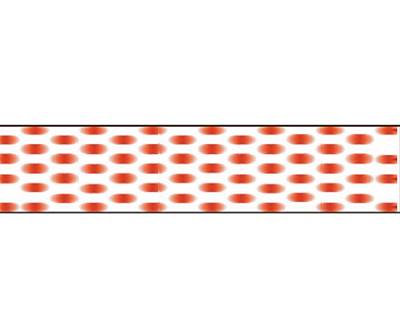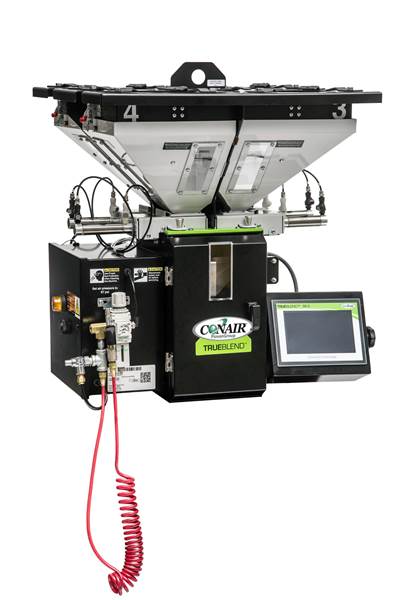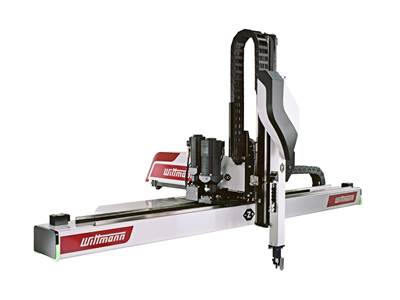Feeding and Blending
Feeding and blending systems are used to meter or dose materials into the primary processing machine. Types include gravimetric blending; volumetric blending; plastics feeding and mixing; plastics dosing.

ESSENTIAL READING
VIEW ALLFive Quick Steps Toward Better Blending
Rising costs of resins and additives, along with higher demands for quality and use of regrind, place a premium on proficient blending. Here are some steps to get you there.
Read MoreHow to Ensure Reliable Feeder Performance When Handling PCR
Processors are being challenged to incorporate more recycled material into their products. Yet there are both economical and technical obstacles to achieving this objective—feeding among them. The design of your feeding equipment and the advantages that it will offer to your process will be more important than ever.
Read More10 Things to Know When Specifying Vacuum Conveying Systems for Powders
The priority is to maximize movement of powders while minimizing dust exposure.
Read MoreUnderstanding Low-Rate Feeding for Continuous and Batch Processes
Molders and extruders that need to feed tiny amounts of material to their process require precision in both the material being fed and the equipment doing the dosing. When a shot size consists of three pellets, there is no margin for error.
Read MoreOptimize Feeding to Get More Money in Twin-Screw Compounding
Follow these practical examples to improve the feeding efficiency and productivity of your process.
Read MoreHow to Troubleshoot Your Feeder to Achieve Optimal Performance
Even the tiniest improvements in compounding feeder accuracy can improve profits. Here’s how to keep your feeding system in the pink.
Read MoreLatest Feeding & Blending News And Updates
Technology 'Fuses' Feeding and Blending
New technology combines the controls of the Maguire WSB gravimetric batch blender with MGF gravimetric feeders positioned beneath or remote to a blender.
Read MorePiovanGroup Announces Transition In Leadership In North America
John Erkert ascends to Regional CEO position for North America as industry veteran Kirk Winstead retires.
Read MoreProgram Provides Equipment Maintenance, Overhauls and Upgrades
NPE2024: Program aims to ensure equipment remains at peak performance levels throughout its life cycle.
Read MoreDryer, Blender for 'Real Time' Regrind Usage
NPE2024: Dri-Air Industries and Maguire Products join forces on the former’s second generation of on-demand drying/blending systems for the circular economy.
Read MorePrecise Blender for Low-Throughput Molders
NPE2024: Gravimetric batch blender precisely delivers precise material blends from up to four ingredients at extremely low throughputs.
Read MoreVolumetric Unit Offers Consistent, Accurate Masterbatch Dosing
NPE2024: Compact feeder mounts directly to the feedthroat of the primary processing machine.
Read MoreFeatured Posts
Smart Works Cells at the Heart of Wittmann’s Exhibit
NPE2024: Under the theme of “It's All Wittmann,” the supplier of injection molding machines, automation and auxiliary equipment is hoping to show NPE attendees what comes with true connectivity.
Read MoreBlending Specialists ABS Relaunching Thoreson McCosh Dryer Line
NPE2024: Advanced Blending is taking the wraps off reinvigorated Thoreson McCosh drying line.
Read MorePlastrac Aims to Make Blending More Energy-Efficient with Brushless Motors
NPE2024: Energy-saving motor also results in more streamlined design, consistent with suppliers move to pack more punch in a small footprint.
Read MoreSafety, Recycling, and Compounding Trends Bring New Opportunity to 70-Year-Old Company
NPE2024: Vac-U-Max presents pneumatic conveying solutions for powdered materials.
Read MoreConnectivity for Material Handling Offers Greater Visibility
NPE2024: Motan solutions integrate data connectivity.
Read MoreFive Quick Steps Toward Better Blending
Rising costs of resins and additives, along with higher demands for quality and use of regrind, place a premium on proficient blending. Here are some steps to get you there.
Read MoreFAQ: Feeding & Blending
How to get better blending?
1. Blend it up close
2. Say no to static
3. Pay attention to receivers
4. Thwart those bridges
5. Learn to deal with regrind
Compounding feeders that don’t feed accurately typically produce off-spec finished products and require extended periods of downtime to recalibrate or fix, resulting in decreased production rates and lost profits. In all industries, the improvement in accuracy performance by even 0.025% of ingredient feeding can result in significant overall profits.
Proper installation, ideal weighing configurations, and appropriate choice of weighing controls can result in the avoidance of a variety of future feeder problems. For a complex feeder system—such as multiple loss-in-weight (LIW) feeders feeding powder and pellets into mixers or extruders—external influences such as vibration, platform stability, and upstream/downstream equipment connections can all affect a feeder’s performance. Informed knowledge of the significance of these influences is key to optimizing its performance.
How to optimize feeding technology?
It is expected that feeder controls can easily connect to industrial networks and key process data, which has become a critical criterion in evaluating not only feeder performance but also real-time indication of the complete process.
Feeding & Blending Supplier Categories
- Blenders (non-intensive)
- Recycled/Reprocessed Materials--Ground Flake Form
- Desiccant for Dryers
- Liquid Mixers
- Conveying Equipment (pneumatic and Mechanical)
- Metal Detectors, Separators
- Silos
- Valves, Gates, Diverters
- Hoppers, Bins, Tanks
- Recycled/Reprocessed Materials--Bale or Bulk Form
- Box Tilters
- Custom Size-reduction (Grinding) Services
- Hopper Loaders
- Motionless Mixers
- Metering, Proportioning Equipment
- Intensive Nonfluxing Mixers
- Dryers for Resins
- Bag and Drum Dumpers
- Semi-bulk Containers
- Feeders
- Intensive Fluxing (melting) Mixers
- Recycled/Reprocessed Materials--Pelletized Form
- Biodegradable, Photodegradable Resins and Compounds
- Weigh Scales
- Tumblers
- Roll Mills

















